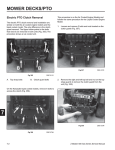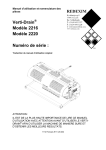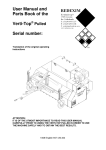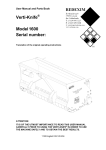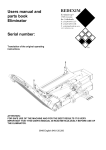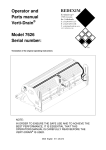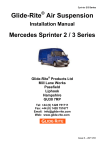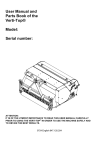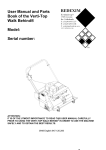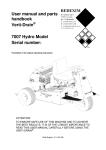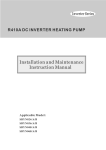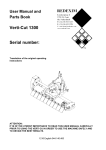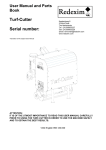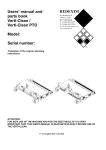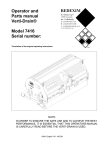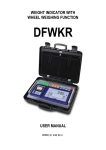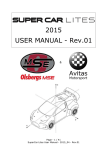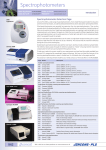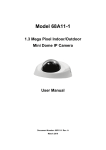Download Verti-Drain 2216 - Charterhouse Turf Machinery
Transcript
User Manual and Parts Book Verti-Drain® Model 2216 Model 2220 Serial number: Translation of the original operating instructions ATTENTION: IT IS OF THE UTMOST IMPORTANCE TO READ THIS USER MANUAL CAREFULLY PRIOR TO USING THE VERTI-DRAIN® IN ORDER TO USE THE MACHINE SAFELY AND TO OBTAIN THE BEST RESULTS. 1213 English 911.120.202 FOREWORD ® Congratulations on your Verti-Drain purchase! For safe and long-lasting operation of this ® Verti-Drain , it is necessary to read and to understand this user manual. It is impossible to work safely with this machine without complete knowledge of its content. The Verti-Drain® is not a machine that works independently. It is the user’s responsibility to use the correct tractor. The user must also check the tractor/Verti-Drain® combination on safety aspects such as noise level, user instructions and risk analysis. ® The Verti-Drain is solely intended for grass fields or areas where grass can grow. The following pages deal initially with the general safety instructions. Every user should know these safety instructions and apply them. At the end of this page, a registration card is inserted. This registration card should be returned to enable us to deal with potential future claims. This user manual lists many instructions that are numbered in sequence. You should follow this sequence. A is an indication of a safety instruction. A means a tip and/or note. All information and technical specifications provided at the moment that this document is published are the most recent ones. Design specifications may be changed without prior notice. This document is a translation of the original operating instructions. Upon request, the original operating instructions are available in Dutch. WARRANTY CONDITIONS WITH DELIVERY THIS VERTI-DRAIN® IS GUARANTEED AGAINST MATERIAL DEFECTS. THIS WARRANTY IS VALID FOR A PERIOD OF 12 MONTHS FROM THE PURCHASE DATE. VERTI-DRAIN® WARRANTIES ARE SUBJECT TO THE ‘GENERAL CONDITIONS FOR SUPPLY OF PLANT AND MACHINERY FOR EXPORT, NUMBER 188’ THAT ARE PUBLISHED UNDER THE AUSPICES OF THE UNITED NATIONS ECONOMIC COMMISSION FOR EUROPE. REGISTRATION CARD For your own information, fill in the table below: Serial number of the machine Dealer name Date of purchase Remarks 2 SAFETY INSTRUCTIONS ® Figure 1 1. The Verti-Drain is designed for safe use. This can only be achieved if you completely follow the safety instructions described in this manual. Read and understand (Figure 1) the manual before you start using the Verti-Drain®. If the machine is not used as described in this manual, this can result in injuries and/or damage ® to the Verti-Drain . The Verti-Drain® is solely intended for work on grass fields or areas where grass can grow. Any other use is improper. The manufacturer will not accept any liability for damage resulting from improper use. All risks occurring with this are entirely at the expense of the user. Following the use, maintenance and repair instructions prescribed by the manufacturer is also considered proper use of this machine. Inspect the area to be treated before using the Verti-Drain®. Remove loose obstacles and avoid irregularities. 2. The Verti-Drain® is manufactured according to the latest technical understanding and is safe to use. When unskilled people use, maintain or repair the machine, this could result in injuries to the user and to third parties. This must be avoided! Always use the Verti-Drain® in combination with the correct tractor as described in the technical data. 3. All persons assigned to operate, maintain and repair the Verti-Drain® by the owner must completely read and understand the operation manual and in particular the chapter of Safety Instructions. The user is responsible for a safe Tractor/Verti-Drain® combination. This entire combination must be tested for noise, safety, risk and user friendliness. User instructions should also be drafted. 4. The user is obliged to check the Verti-Drain® for visible damage and defects before using the Verti-Drain®. Modifications to the Verti-Drain® (including its operations) that have a negative impact on safety must be rectified immediately. For safety reasons it is in principle not permitted to make changes or adjustments to the Verti-Drain® (except those approved by the manufacturer). If modifications to the Verti-Rake have been made, then the current CE marking is cancelled. The person that has made these modifications has to apply for a new CE marking himself. Check the Verti-Drain® for loose bolts, nuts and components before every operation. 3 If present, check the hydraulic pipelines regularly and replace these when the hydraulic pipelines are damaged or appear old. The pipelines that are replaced should comply with the technical requirements of the manufacturer. If a hydraulic installation is present, you should always make it pressure-free before working on this installation. NEVER use the Verti-Drain® in the absence of protective guards and safety stickers. NEVER crawl under the Verti-Drain®. If necessary, tilt the Verti-Drain®. NEVER step off the tractor while the motor is running. In case of maintenance, adjusting and repairs, it is necessary to block the Verti-Drain® in order to prevent sinking away, driving off and/or sliding off. Always switch off the tractor motor, take the tractor’s key out off the ignition and disconnect the Power Take-Off (PTO) in case of maintenance, adjusting and repairs (Figure 2). Figure 2 With regards to the safety of the machine and the user, use only original Verti-Drain® parts for maintenance and repairs. Only authorised technical personnel may carry out repairs to the Verti-Drain®. Keep a record of the repair activities. 5. The general applicable health & safety (Dutch: ARBO) regulations must also be followed in addition to the instructions in this user manual. Relevant traffic regulations also apply in case of using public roads. Transporting persons is not permitted! Do not use the Verti-Drain® in the dark, in heavy rain/storm or on slopes with an angle larger than 20 degrees. 4 6. All persons that are going to operate the Verti-Drain® must be familiar with all the functions and control elements of the Verti-Drain® before starting any work activities. Attach the Verti-Drain® to the towing vehicle according to the regulations. Check whether you have a clear field of vision – both close by and far away – before you depart. Safety stickers with an identical meaning are attached to the sideboard (Figure 4, 5 and 6) ® and to the rear cover (Figure 3, 4 and 5) of the Verti-Drain . These safety stickers must always be clearly visible and legible and must be replaced if they have become damaged. During operation, NO persons are allowed within the danger zone of the Verti-Drain®, because there is danger of physical injuries caused by moving components. (Figure 3) Figure 3 Figure 4 Keep a distance of minimum 4 metres! (Figure 4) The rear cover must always be closed and undamaged while operating the machine! (Figure 5) BE CAREFUL not to get any parts of your body jammed! (Figure 6) Figure 5 Figure 6 Pay attention to the permitted lifting capacity of the towing vehicle. Dress appropriately. Wear sturdy shoes with steel toecaps, long trousers and tie up long hair. Do not wear loose clothing. 5 7. Location of the safety stickers (Figure 7) Figure 7 Used oil/grease is harmful to the environment. Dispose of these substances according to the regulations that apply in your location. 6 EU DECLARATION We – Redexim BV, Utrechtseweg 127, 3702 AC Zeist, Holland – declare entirely under our own responsibility that the product VERTI-DRAIN® WITH A MACHINE NUMBER AS INDICATED ON THE MACHINE AND INDICATED IN THIS MANUAL to which this declaration refers, complies with stipulation of the 2006/42/EC machine directive. Zeist, 23.03.12 A.C. Bos Manager Operations & Logistics Redexim Holland 7 TABLE OF CONTENTS FOREWORD .............................................................................................................. 2 REGISTRATION CARD ............................................................................................. 2 SAFETY INSTRUCTIONS .......................................................................................... 3 EU DECLARATION .................................................................................................... 7 1.0 TECHNICAL DATA.......................................................................................... 9 2.0 GENERAL DESCRIPTION ............................................................................ 10 3.0 FIRST INSTALLATION – TAKING THE MACHINE OFF THE PALLET AND ATTACH TO THE TRACTOR ........................................................................ 10 4.0 THE POWER TAKE OFF (PTO).................................................................... 11 4.1 LENGTH OF THE PTO.................................................................................. 11 4.2 USING THE PTO ........................................................................................... 12 4.3 SLIP COUPLING INFORMATION AND MAINTENANCE ............................. 12 5.0 ADJUSTING THE WORKING DEPTH .......................................................... 15 6.0 ADJUSTING THE PIN ANGLE ...................................................................... 15 7.0 DRIVING SPEED ........................................................................................... 16 8.0 START PROCEDURE ................................................................................... 17 9.0 USING THE VERTI-DRAIN® ......................................................................... 18 10.0 TRANSPORTING THE VERTI-DRAIN®........................................................ 18 11.0 DETACHING THE VERTI-DRAIN® ............................................................... 18 12.0 TROUBLE SHOOTING (PROBLEM ANALYSIS) ......................................... 19 13.0 MAINTENANCE............................................................................................. 20 14.0 TECHNICAL INFORMATION: GREASE POINTS......................................... 21 14.1 THE CRANKSHAFT ...................................................................................... 22 14.2 REPLACING A CRANK / CRANK BEARING ............................................... 22 14.3 REPLACING AN OIL CATCHER .................................................................. 22 14.4 ELIMINATING THE CRANKSHAFT TENSIONS ........................................... 23 14.5 TIMING AND TIGHTENING MOMENTS ....................................................... 25 15.0 OPTIONS: THE TURF HOLD DOWN KIT..................................................... 25 15.1 OPTIONS: PINS ............................................................................................ 26 15.2 OPTION: WINDROW KIT .............................................................................. 27 15.3 OPTION: HYDRAULIC DEPTH ADJUSTMENT............................................ 28 8 1.0 TECHNICAL DATA Model 2216 2220 Working width 1.60 m (63”) 2.08 m (82”) Working depth Up to 225 mm (9”) Up to 225 mm (9”) Tractor speed measured at 540 rpm on the PTO: Hole distance 65 mm Up to 1.79 km/h (1.1 mph) (2.6”) Up to 2.48 km/h (1.5 mph) Hole distance 90 mm (3 1/2”) Up to 3.58 km/h (2.1 mph) Hole distance 130 mm (5.1”) Max. PTO rpm: Up to 540 rpm Weight 840kg (1851 lbs) 1030kg (2270 lbs) Hole distance between the pins Hole distance in the driving direction 65 mm (2.5”) for 12 mm (1/2”) holes 130 mm (4”) for 24/18 mm (1”/3/4”) holes 25-195 mm (1”-7.5”) Recommended tractor 45 PK with a lifting capacity of minimum 1050 kg (2314 lbs) 50 PK with a lifting capacity of minimum 1300 kg (2866 lbs) Up to 2796 m²/h (30096 ft²/hr) Up to 3728 m²/h (40128 ft²/hr) Up to 3871 m²/h (41672 ft²/hr) Up to 5162 m²/h (55562 ft²/hr) Up to 5592 m²/h (60193 ft²/hr) Up to 7456 m²/h (80257 ft²/hr) 1210 x 1700 x 900 mm (47.6” x 66.9” x 35.4”) 1210 x 2220 x 900 mm (47.6” x 87.4” x 35.4”) Maximum capacity Hole distance 65 mm (2.6”) Hole distance 90 mm (3 1/2”) Hole distance 130 mm (5.1”) Machine dimensions Maximum pin dimension Solid 24 x 225 mm (1”x 9”) Hollow 25 x 225 mm (1”x 9”) Three-point connection 3-point CAT. 1/2 Gearbox oil Lifetime Grease EP 00 (6Kg / 13.2lbs) Grease EP 2 Standard components • • • • • Set of solid pins 18x225 (3/4”x 9”) Set of adaptors 24 to 18 mm Rear roll Cylinder with tools and user manual PTO 9 • • • • • Optional 2.0 Solid pins Hollow pins Turf hold-down fingers Windrow kit Hydraulic front roll adjustment GENERAL DESCRIPTION ® ® The Verti-Drain is a machine for aerating grass and sport fields. The Verti-Drain is a 3® point machine. You will need a tractor in order to use the Verti-Drain . 3.0 FIRST INSTALLATION – TAKING THE MACHINE OFF THE PALLET AND ATTACH TO THE TRACTOR Figure 8 The machine is placed vertically on the pallet. To remove the pallet and to place the machine horizontally on the ground, take the following steps (see Figure 8): 1. 2. Remove the PTO, PTO protective covers and pins from the machine. Attach a cable to the crane hooks. 3. Make sure that the cable/crane/lift can hoist at least 2 times the weight of the machine. (For the weight see chapter 1.0 technical data) Lift the machine including the pallet of 50 mm (2”) off the ground. 4. 5. 6. 7. NEVER crawl under the machine! Remove the pallet (1). Slowly lower the machine until the 3-point junction plates touch the ground. Slowly lower the machine further so that it can turn on its front roller. Carefully lower the machine further until it stands on its front and rear roller. 10 8. 9. Assemble the PTO Cover 2 that is included with the supplied items. Attach the machine to a tractor. Use the proper tractor (please refer to the specifications). 10. Attach the hydraulic hoses to the tractor. 11. Lift the machine off the ground. 12. Remove the locking pins of the rear roller (3) and mount these in the appropriate hole (4). 13. Place the machine on the ground and adjust the angle of the machine to 90° by turning the top rod. This 90° angle is very important for the proper fun ctioning of the machine. 14. Set the stabilizer of the tractor to 100 mm lateral stroke. 15. Assemble the pins. Apply some grease to the spindle. 16. Please refer to Section 4.1 for the length of the PTO. 4.0 THE POWER TAKE OFF (PTO) The PTO is a very important component. It takes care of the drive from the tractor and safe use of the machine, provided it is installed and maintained in the correct manner. The PTO has its own CE certification. Read the PTO manual. This manual is located on the PTO. Figure 9 4.1 LENGTH OF THE PTO The length of the PTO is very important. If it is too long, it can damage the drive of the tractor and/or the Verti-Drain®. If the overlapping length of the cylinders becomes less than 150 mm (6”) at any time, it can damage the PTO. The length changes when the machine is lifted or when a different tractor is used! 11 In order to set the PTO on the correct length, when a new one has been purchased or when a different tractor is used, follow these steps: (see Figure 9) 1. 2. 3. 4. 5. 6. 7. 8. Measure the distance between the PTO’s connection to the tractor and to the Verti-Drain, from groove to groove, when the machine is connected to the tractor and positioned on the ground at the right angle. Measure the distance B of the PTO in its shortest position from the locking pin to the locking bolt. Divide the PTO in two parts and remove the protection cap at both ends. The ends of the cylinders and the ends of the protection caps must be made shorter: (B-A) + 75 mm (3”). Smooth off all components, use some grease, and then assemble all components. Mount the PTO on the side of the Verti-Drain. Attach the other end of the PTO to the tractor. Check the overlap of the cylinders. Never use the machine if it has a damaged PTO protection cap. First remove any damaged parts. 4.2 USING THE PTO The following items must be checked for correct use of the PTO: 1. 2. 3. 4. 5. 4.3 While working the angle of the pivot pins may not exceed 30 degrees. The pivot pins must always be aligned. The overlap of the cylinders must always be minimum 150 mm. Never use the machine if it has a damaged PTO protection cap. For lubrication see section 13.0: Maintenance. SLIP COUPLING INFORMATION AND MAINTENANCE If used and maintained correctly, the slip coupling will protect your machine against damage. The following items are important: 1. The length of the spring is standard set at 33 mm (1.300”) 2. Whenever the slip coupling slips, the bolts/nuts can be tightened a quarter of a turn until you achieve a minimum length of 31.5 mm (1.250”) of the spring. Additional compression will overload the machine. Screwing the bolts/nuts too tight could ultimately damage the machine or create unsafe situations. 3. - The slip coupling must be maintained on a monthly basis. Follow the following steps: Disconnect the top PTO protection cap from the machine. Loosen up all the bolts/nuts by 2 turns. On the field let the machine run at very low revs. 12 - - - - If the coupling slips, stop the motor after 10 seconds. If the coupling does not slip, loosen up the bolts further or proceed with the maintenance / annual maintenance task (see point 4 below). As soon as the coupling has slipped, screw the bolts/nuts tight until you see that the slip coupling is once again functioning properly. * Do not turn it back again to the previous setting. 4. Annual maintenance: Disconnect the PTO from the machine. Inspect all the components of the PTO. All the damaged components should be replaced. Take the slip coupling apart by removing all the bolts and nuts that fasten the springs to each other; the slip coupling should then simply fall apart. Lay down all the components and look at them meticulously. If components are damaged or worn out, replace them. Clean all interlocking components. Re-assemble all the components and tighten the bolts and nuts so that the springs are adjusted to 33 mm (1.3”). Grease both cylinders and reassemble both PTO parts. Assemble the PTO and mount it on the machine. In needed, brush the springs of the slip coupling as described below. If adjusted properly, the slip coupling protects the machine only against momentary overload. Long-term overload will damage the machine. In such cases the slip coupling cannot protect the machine. Do not overload your machine. 13 m 457 ) 18" ( m Fig. 10 14 5.0 ADJUSTING THE WORKING DEPTH The working depth can be adjusted when the machine is lifted, see Figure 10. Tighten the nuts one by one turn on both sides of the machine. Then turn on or off spindle 3. The sticker 2 on the side of the machine, the depth setting. If the correct working depth is reached, tighten the nuts 1 again. Adjust one side never more than 4 strokes. Compensate the other side first, before continuing. The depth adjustment on the stickers applies only if one uses pins of 225 mm (9“). If shorter pins are used, deduct the difference in length compared to the 225 mm (9”) from the values on the sticker. To prevent too much dragging of the rear roller in case of shallow pricking, pushing the protection pin (3) in one of the holes (5) will block the rear roller (see Figure 8). 6.0 ADJUSTING THE PIN ANGLE All pins can be adjusted simultaneously with the handles (4) at the side of the machine (see Figure 10). Raise the machine above the ground and loosen the check nuts (5) at both sides of the machine. Adjust the angle by putting the supplied ring spanner on the hexagon (6) of the handle (4). The indicator (7) gives the angle. Remove the supplied ring spanner and tighten the check nuts (5). A 90° angle means hardly any pin movement. A 90° an gle is required for hollow pins and is recommended for pins of 8 mm (5/16”). A 90°-70° angle means more pin movement. This is re commended for solid pins and depends on the soil conditions, the pin measurement and the requirements of the client. In case of 90°, the pins go into the ground perpend icularly only if the machine is correctly installed (see Figure 10). If the machine is incorrectly installed, a force F can occur which damages the machine. The length of the combined drawbar must be 457 mm (18”). This can be calibrated by means of shims (see Parts page). 15 7.0 DRIVING SPEED mph km/h 2,18 2,50 2,02 3,25 1,86 3,00 1,71 2,75 1,55 2,50 1,40 2,25 1,25 2,00 1,10 1,75 0,95 1,50 0,80 1,25 0,64 1,00 0,48 0,75 0,32 0,50 0,16 0,25 0 0 D 0 0 25 1 50 2 75 3 100 4 125 5 150 6 mm inch Figure 11 The driving speed determines the distance D between the holes in the driving direction (see Figure 11). If the client requires a smaller distance between the holes, you have to drive slower which depends on the possibility to reduce the tractor speed. Figure 12 provides a table with the correlation between the driving speed and the distance between the holes. If the driving speed of the tractor at 540 rpm on the PTO is known, the distance between the holes can be determined. The incoming revolutions of the PTO may be maximum 540 rpm. If you expect hard objects, you must reduce the speed. The pin holders can start floating in case of using heavier pins, other applications or maximum pin angle. Reduce the revolutions before the pin holders slam upwards. If the Verti-Drain is incorrectly attached to the tractor, the different PTO angles can cause vibrations in the driveline of the machine (see Figure 8). These vibrations can damage the machine and the holes in the ground. If the PTO is shortened incorrectly or if another tractor is used, the gearbox may be overloaded. This can result in damage. 16 8.0 START PROCEDURE Figure 13 The start procedure is VERY important. If this procedure is not executed as described below, it might result in serious damage to the machine. The start procedure is as follows (see Figure 12): 1. 2. 3. 4. 5. 6. 7. Move to the location where you want to start. Lower the machine until the lower pins almost touch the ground. Adjust the tractor engine to around 1200 rpm. Put the tractor in the correct gears and drive forwards (A). Engage the PTO (B). WHILE IT TURNS, lower the machine CAREFULLY into the ground DURING the forward drive (C). Increase the PTO’s revolutions to the maximum allowed value. Stopping occurs as follows: 1. Decrease the engine revs to approx. 1200 rpm. 2. Lift the machine off the ground. 3. Detach the PTO as soon as the pins are out of the ground. 4. Raise the machine further until the pins are minimum 120 mm above the ground. 5. Go to the next location and start again as described above. It is absolutely vital to work according to the aforementioned procedures! If the machine is lowered to the ground WITHOUT a turning PTO, the machine can be severely damaged. Always lower the machine CAREFULLY. Be careful when reversing. During the work activities, the front roller has to be adjusted to the ground in a stable manner. If the machine is unstable, other pins should be mounted or the working depth has to be adjusted. Failing to eliminate the instability will damage the machine. The machine is NOT protected against this continuous overload. Never reverse with the pins in the ground or close to the ground. Do not use a hydraulic top rod. 17 9.0 USING THE VERTI-DRAIN® ® Before using the Verti-Drain in a location, you should check the following items: 1. Are there loose objects in the field? First remove these objects. 2. Are there slopes? The maximum slope is 20 degrees for this machine. 3. Always go from top to bottom. 4. Are there cables/pipes buried in the ground? If so, determine their depth and adjust the working depth of the machine to 60% of the depth of the cables/pipes. 5. Are there hard objects in the ground? If so, use the Verti-Drain® with a low PTO speed and adjust the working depth. 6. Is there danger of flying objects (e.g., golf balls) that distract the attention of the driver? If so, the Verti-Drain® CANNOT be used. 7. Is there danger of sinking/sliding away? If so, postpone using the Verti-Drain®. 8. If the soil is frozen or very wet, postpone the activities until conditions improve. 9. If the soil is very compressed, use shorter pins or adjust the working depth. 10.0 TRANSPORTING THE VERTI-DRAIN® ® The user is responsible for transporting the Verti-Drain in back of the tractor over public roads. Verify the national legislation regarding the regulations. On open fields while the machine is raised, the maximum permitted speed is 12 km/h (8 mph) due to the weight of the Verti-Drain®. A higher speed can be dangerous for the driver and/or the public and can even damage the machine. When the machine is raised off the ground, the front axle of the tractor has to support minimum 20% of its weight. 11.0 DETACHING THE VERTI-DRAIN® The machine can be detached from the tractor in the following manner: 1. Open the rear cover. 2. Turn the crankshaft until all the pins are in the highest position possible. 3. Place the machine with both rollers in the highest position on a solid underground. 4. Block the guide of the rear roller with the locking pins (3) (see Figure 8). 5. Block the front and rear roller to prevent them from rolling away. 6. Remove the top rod. 7. Loosen the PTO at the side of the tractor. 8. Remove the Verti-Drain‘s lower arms from the tractor. Turn the tractor engine OFF if you walk around the machine and block the tractor from moving! 18 12.0 TROUBLE SHOOTING (PROBLEM ANALYSIS) Problem Machine vibrates. Possible cause Crankshaft turns irregularly. Difficult conditions Solid/hollow pins break and/or bend. Wrong pin Difficult conditions Front roller does not stand stable on the ground. Rapid wear & tear Wrong pins; too much resistance. Difficult conditions PTO breaks. Damage to the drawbars Damage to the lawn Pin is not fixed to the pin holder. Solution Machine is not set to 90°. Angles of the PTO’s turning points are different. PTO’s turning points are not aligned. Adjust the working depth. Use shorter/thinner pins. In case of drought, first sprinkle water. Change the pin; use shorter ones. Use solid pins in front of the hollow pins to break the soil open. Adjust the working depth. Use shorter/thinner pins. In case of drought, first sprinkle water. First use solid pins to break up the soil. Adjust the pin angle. Change the pin size. Adjust the working depth. Use different pin sizes. First sprinkle water. Adjust PTO as described in chapter PTO angles are too large. PTO angles are not the same. 4.0 Bending / breaking Machine is not set to 90°. Centre bar is bent. Bearing bushes are worn. Pins touch the ground when reversing the machine. Lifting height is incorrect. Oval holes Soil is too wet. Change the pin angle setting. Reduce the forward driving speed. Adjust the working depth. Use thinner pins. Soil too wet Postpone operation Difficult conditions Use different pins. Grind a flat part to the pins. Adjust the pin angle. 19 Problem Possible cause Solution Crankshaft problems Big-end nuts come undone. Rectify the vibration (see vibration) Crankshaft bearing is worn. Incorrect assembly after repair. Remove, clean and use Loctite. Rear roller vibrates. Locked rear roller. Rear roller is in upward position during pricking with hollow pins. Unlock. Change the speed and the PTO revs. Put roller free from the ground. Change the machine settings. (Gearbox in position 1.) Difficult conditions 13.0 MAINTENANCE Time schedule Before every use Check/Grease point Method Check for loose bolts/nuts. Tighten loose bolts/nuts with the correct tightening moment. Attach the machine to a tractor and operate the machine for 5 minutes. Listen and observe any strange movements/sounds. Check the oil level in the gearbox. It has to reach at least the halfway mark of the gauge. If necessary, use Lifetime grease EP 00. Presence and readability of the safety stickers (Figure 7) Replace these if not present or damaged. Loose hanging parts around the PTO After the first 20 working hours (new or repaired) Tighten the parts so that they cannot reach the PTO. Grease PTO, roller bearings and Use EP2 grease crankshaft bearings. Check for loose bolts/nuts. Tighten loose bolts/nuts with the correct tightening moment. Attach the machine to a tractor and operate the machine for 5 minutes. Listen and observe any strange movements/sounds. Check the gearbox for oil leaks. Replace the seals/sealing paste. 20 Time schedule Check/Grease point Method After the first 20 working hours (new or repaired) Loose hanging parts around the PTO Tighten the parts so that they cannot reach the PTO After every 50 working hours Grease PTO, roller bearings and Use EP2 grease crankshaft bearings. Check for loose bolts/nuts. Tighten loose bolts/nuts with the correct tightening moment. Attach the machine to a tractor and operate the machine for 5 minutes. Listen and observe any strange movements/sounds. Check the gearbox for oil leaks. Replace the seals/sealing paste. 14.0 TECHNICAL INFORMATION: GREASE POINTS Fig. 13 21 14.1 THE CRANKSHAFT Figure 14 illustrates the composition of the crankshaft. Also look at the Parts page for a more detailed drawing. In this machine the angle between the crank cheeks on the gearbox must be 0°. 14.2 REPLACING A CRANK / CRANK BEARING Replacing a crank is necessary if the crank is cracked or if the big-end nuts come undone regularly. Then the crank bearings or the crank bearing fittings or the big-end pinholes are damaged. To prevent further damage to other parts, as soon as possible replace the crank / bearing as follows (see Figure 14): 1. 2. 3. 4. 5. 6. Remove the big-end nut (1) and the big-end (2). Remove the nuts (3). Remove the combined bearing block (4). Remove the nuts (5) and the profile shaft (6). Remove the seals (7) and bearings (8) from the bearing block (4). Replace the faulty parts and assemble in the reverse order. Use new lock plates (9) 7. • Assemble the elements (10) in the correct manner (see Section 14.5). Use Loctite for the big-end nut (1) and the nuts (3). 14.3 REPLACING AN OIL CATCHER Figure 14 provides a view of the crankshaft. Replacing an oil catcher in the gearbox is done as follows: 1. 2. 3. 4. 5. 6. 7. 8. 9. 10. 11. 12. 13. Remove the nut (11) on the second crank element (12) – counted from the gearbox – that might be stuck due to the use of Loctite. Heating it may help. Pull the big-end (13) a bit backwards until the element (12) comes loose. Remove the connecting rod (14) by removing the pin (15). Remove the nut (16), lock plate (17) and the crank element (18) from the gearbox. Mark the position of the crank element before removing it! Using a screwdriver, remove the oil catcher (19). Clean the area and remove any oil and grease. Assemble the new oil catcher. Apply some grease on the inside of the oil catcher. Clean the crank element (20) and kit the splines with silicone sealant. Assemble the crank element in the correct position (according to the marking)(See fig.15). Fill the space between the handle and the axle with silicone sealant. Assemble a new lock plate (17) and nut (16). For the nut, use Loctite. Tighten the nut (16) with a torque as indicated in Figure 15. Assemble the other parts in reverse order. 22 14.4 ELIMINATING THE CRANKSHAFT TENSIONS If the parts in the crankshaft are replaces, the crankshaft can run heavier. Pre-tension can be the cause. It is necessary to eliminate these tensions as follows (see Figure 14): 1. 2. 3. Loosen the nuts (3) of the bearing blocks (4)a few turns. From the centre of the gearbox, tighten the bearing blocks (4) one by one. After each bearing block (4), check whether the crankshaft runs smoothly and without play. After repairing the crankshaft, you must regularly check whether nuts come undone. Assemble the cranks in the correct manner. See the Parts page for the correct order and part numbers. 1 2 3 12 11 13 4 6 7 14 8 8 7 10 15 9 5 Apply threadlocking agent Apply silicone sealant 19 17 18 13 16 Apply silicone sealant Fig.14 23 Left version 2220 - Cranks 90° Right version Left version ! IMPORTANT ! Use correct side watch marker points. (Only VD2216) 2216 - Cranks 120° Right version 800Nm (590 lbf.ft.) 800Nm (590 lbf.ft.) 800Nm (590 lbf.ft.) 800Nm (590 lbf.ft.) 110Nm (81.1 lbf.ft.) 170Nm (125.4 lbf.ft.) 170Nm (125.4 lbf.ft.) 450Nm (331.9 lbf.ft.) 170Nm (125.4 lbf.ft.) Fig. 15 24 14.5 TIMING AND TIGHTENING MOMENTS Figure 15 indicates the tightening moments of the major bolts and nuts. Make sure that the tightening moments of bolts and nuts, which are not listed in Figure 15, are the same as the tightening moments of comparable bolts and nuts. If bolts and nuts come undone, Loctite may be used to tighten them. 15.0 OPTIONS: THE TURF HOLD DOWN KIT Figure 17 You can use a turf-hold-down kit if a layer of Turf comes loose. The following Turf-Hold-Down Kits are available: • • • • 2216 for 12mm (1/2”) pins, order number: 2216 for 24mm (1”) pins, order number: 2216 for 12mm (1/2”) pins, order number: 2216 for 24mm (1”) pins, order number: 211.116.004 211.116.002 211.122.004 211.122.002 A standard feature of the Verti-Drain 2220 is a pre-mounted main bar to which you can attach the turf-hold-down fingers. The kit consists of a set of turf-hold-down fingers for 12 mm (1/2”) or 24mm (1”) pins and the attachment material consisting of a number of bolts and nuts. ASSEMBLING THE TURF-HOLD-DOWN KIT (see Figure 17): - Included in the ordered set are the plates (1). Attach the plates to the main bar using bolt (2), ring (3) and nut (4). Align the plates with the pins via the slotted holes in the plates. - If the plates are bent in one direction after extensive use, you attach them the other way around. OTHER REMARKS: - If the pins are no longer in the centre of the machine, they might touch the sides of the slots. Realign the pin locks. - Check the length of the drawbar if the pins touch the front side of the hole during work activities. NEVER crawl under the machine! Make sure the machine is firmly blocked! 25 15.1 OPTIONS: PINS Pins are vital for the proper functioning of the machine. Different pins are available for this machine. See the Parts page for a complete overview. Generally speaking, the pins can be divided into two categories: solid and hollow pins. We recommend using only original pins, because they are completely adjusted to the machine. The pin holders have 4 x 12 mm (½”) and 2 x 24 mm (1”) holes for attaching the pins. The locking bolt A may be tightened with a torque of 40 Nm/30 lbf.ft. (See Figure 18) The locking bolt B may be tightened with a torque of 70 Nm/50 lbf.ft. (See Figure 18) If a pin comes loose from its pin holder, grind a flat part to the assembling side of the pin. SOLID PINS Solid pins break open the hard compressed soil. The pin angle setting (see Chapter 6.0) determines the amount of pin movement in the soil. The pin movement becomes larger if the angle is adjusted from 90° to 70°. There is almost no pin movement if the setting is 90°. If the pins are new, they can damage the lawn – certainly if the roots of the grass are weak. First, clean the pins manually or use the machine for 10 minutes on another rough underground. If the roots of the grass are weak, adjust the working depth in such as manner that the pricking depth is slightly deeper than the length of the roots. This way the roots have a chance to grow deeper. The next time prick deeper. Applying this method will prevent damage to the lawn and ensures a healthy set of roots. We recommend using solid pins with the sharp point in the direction of the front roller. This method ensures the best pin movement in the soil. On the other hand, we recommend using pins with the sharp point in the direction of the rear of the machine in case of a lawn with weak roots. Figure 18 26 Always use pins of the same thickness and length. Replace a bent pin immediately. If you don’t do this, the machine can become unstable. Do NOT use thicker and/or longer pins than the ones we supply. Shorter (worn) pins can be used if superficial pricking is required. Be aware of the fact that the working depth indicated on the sticker will only be correct if the maximum length of the pin is used. Oval holes are created if the top layer is weak and the substrate has a hard layer. Use thinner pins or wait until the wet top layer has dried. If top dressing should be applied, apply this first before using the Verti-Drain. If the soil is hard to prick, sprinkle water on the soil. Afterwards, use thinner and shorter pins or adjust the working depth. If this is not done, the machine will ultimately suffer damage. HOLLOW PINS The soil can be mingled with hollow pins. Various sizes are available (see the Parts page). The opening of the pin should be in the direction of the rear of the machine. In case of using hollow pins, it is important that the pin angle is set to 90°. The pin movement in the soil is minimal and this way you make a nice ‘clean’ hole. The pin can ultimately break if the pin always moves in the soil under an angle smaller than 90°. If top dressing should be applied, use the Verti-Drain first, remove the ‘cores’ and afterwards, scatter the sand. If a lot of dirt is created during pricking with hollow pins, reduce the revolutions or sprinkle water. Dirt can cause wear & tear to your machine. If the lawn becomes damaged, use solid pins first in order to create a set of healthy roots or adjust the working depth. If the pins jam, then the soil is very compressed. First, you should use solid pins to break open the soil and then sprinkle water or adjust the working depth. 15.2 OPTION: WINDROW KIT If hollow pins are utilized, cores are removed from the substrate. The Windrow kit ensures that the cores are neatly guided together after the Verti-Drain operation, after which they can easily be removed. The kit can be ordered with number: • • VD2216: 211.116.008 VD2220: 211.122.008 27 15.3 OPTION: HYDRAULIC DEPTH ADJUSTMENT The machine is equipped with a standard mechanical depth adjustment. If desired, the machine can be converted to a hydraulic depth adjustment. The hydraulic depth adjustment can be ordered as an option with number: • • VD2216: 211.116.006 VD2220: 211.122.006 The conversion procedure is as follows: (See fig. 19) For parts, refer to the parts manual. Left side of the machine looks at the input as being left. Right side of the machine looks at the input as being right. 1. Position the Verti-drain on a firm underground and secure the Verti-Drain against sinking away. Take care that the front roll can move freely and that the Verti-Drain is not leaning on this. 2. Remove the covers (1). 3. Turn the front roll (2) downwards so that it is just leans on the ground and the spindles (8) are free of tension. 4. Remove the nuts (3). 5. Remove the plates (4). 6. Install the plates that were included in the kit, # 464.203.400 (5) and 464.043.100 (6). 7. Add bracket 468.031.402 (7) on the left side of the machine and bolt everything together. 8. Repeat steps 4 to 7 on the other side of the machine. 9. Remove spindle (8), together with cylinder (9) on the left side. 10. Mount cylinder 534.252.002 with shaft diameter 25mm (1”) (10) with the included cylinders (11) and bolts (12) on the left side of the machine. Use the existing bolts for attachment to the support (15). 11. Remove spindle (8), together with cylinder (9) on the right side. 12. Mount cylinder 534.252.004 with shaft diameter 30mm (1,2”) (10) with the included cylinders (11) and bolts (12) on the right side of the machine. Use the existing bolts for attachment to the support (15). 13. Mount the hoses to the cylinders and the other hydraulic components as indicated in the parts manual. 14. Mount the covers (1) onto the machine. 15. Attach the hose blocks (13) and the other hydraulic components to the covers (1). 16. Mount the working depth indicator (14) onto the cover (1), feed the cable through the cover (1) and attach the end to the support (15). Use a thread-locking sealant on the bolt to prevent loosening. 17. Adjust the working depth indicator (14) so that it registers the same depth as the indicators (16) on the sides of the machine. 18. Check that all attachments are secure and attach the machine behind a tractor, as described in chapter 3.0. VENTING THE HYDRAULIC DEPTH ADJUSTMENT: 1. Connect the hydraulic hoses to the tractor. 2. Lift the machine off the ground. 3. Open the faucet (17) located on the right side of the machine by turning it to the left (by using the included key) to vent the hydraulic depth adjustment system. 4. Activate the hydraulic outlet of the tractor and let the front roll move downwards carefully to remove the air from within the system. 28 5. Close the faucet (17) located on the right side of the machine by turning it to the right (use the included key). If there is still air in the machine, repeat 3 to 5 until all air is removed. The system is now vented and ready for use. Ensure that both sides of the machine are moving up and down parallel to each other. If this is not the case, stop the movement immediately to prevent damage to the machine. 1 1 2 7 8 4 5 6 11 12 3 17 10 3 11 9 12 16 13 14 13 13 13 13 15 Use threadlocking sealant 13 Fig. 19 29





























